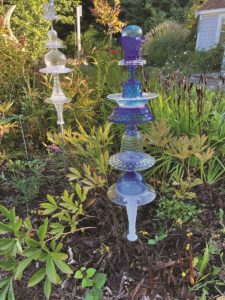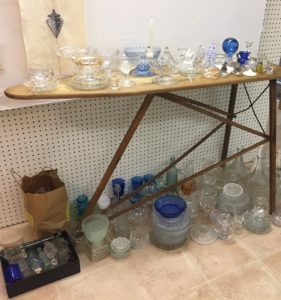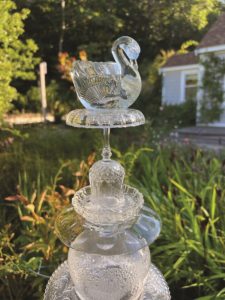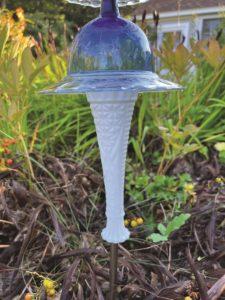Lucy LaFleche is one of the people who helped get me through the pandemic. And it wasn’t just the big-girl-size Cosmos she was known to pour moments after five o’clock.
Lucy is a gifted textile artist and an unapologetic recycler of everyday materials into beautiful objects — her studio in Orleans is a kaleidoscope of fabrics, papers, vintage post cards, and other finds waiting to be reconfigured into something beautiful. Her response to the chaos was to establish a monthly arts-and-crafts salon.

Our little pod embroidered vintage napkins. We delved into a Japanese mending style called boro to create books out of scraps of fabric. We dyed cloth with acorns and wildflowers. We fashioned delicate vessels of vintage paper. While the world seemed to be tumbling down, we turned our attention to creating.
I basked in Lucy’s enthusiasm for the process of making things — whatever the outcome. She professes a steadfast faith in the power of creativity to soothe and heal. I wasn’t sure about that last part. I tend to be a little cynical; woo-woo is not my style. But I looked forward to the salons. And this summer I missed them.
So, I was happy to get an invitation from Lucy in August. She had found inspiration in garden sculptures she’d seen at a consignment store up Cape. “Wait till you see,” she said. “Come on Friday and we’ll make our own.”
The repurposing of cast-off glass spoke to Lucy’s devotion to making old things new again, and in preparation for a get-together she haunted thrift stores and garage sales up and down the Cape.

When I arrived at her studio on the appointed day, I stood face to face with a cache of cast-off plates, cups, glasses, and bowls so extensive that it would have made Bloomingdale’s jealous. There were simple Anchor Hocking glass plates and bowls alongside faceted and etched serving bowls and platters, and slinky ’50s cocktail glasses, finger bowls, decanter stoppers, and other tchotchkes. I hadn’t seen this many ashtrays since I lived with my parents 42 years ago, nonchalantly breathing in their Tareyton haze.
Before we began to assemble the glass pieces, we fashioned a base composed of a hollow half-inch metal rod, about 36 inches long, like a thin curtain rod, which would eventually be inserted in the ground to anchor our garden sculptures, and an inverted old-fashioned florist’s bud vase. The vase was secured to the rod with a clear silicone glue that, according to the label, adheres to everything in the known universe. It definitely secured a carelessly placed bowl to Lucy’s worktable.
While the base dried, we selected components for our sculptures from the warehouse of glass Lucy had assembled. I chose clear plates in various sizes, a brandy snifter, a faceted cordial glass, a coaster, a cut-glass bowl, a blue water glass, what looked like a decanter stopper, an odd blue glass top hat, and a swan.

I then spent some time arranging and rearranging these elements in various configurations. It became clear that a stable and harmonious sculpture requires that the bottom of the structure carry the most actual and visual weight, tapering as it goes up. I used a large dinner plate for the lowest tier of my first sculpture. We also realized that the bowls and plates should be upside-down so that their lips won’t collect water for breeding mosquitos.
Then came the gluing. Each ascending element must be able to sit flush on the element below it in order for the glue to form a solid bond. This required the reshuffling of some of the plates and bowls. A thin bead of glue is piped onto the rim of the bowl that will be stacked and inverted on the first dinner plate. For each new level there is another dish and a bead of glue.
Next to me, Sue Siegel, a collage artist who has Front Porch Gallery in Wellfleet, was not creating a garden sculpture. Instead, she was making a giant candelabra, which followed the same basic pattern but with an upside-down bowl as the base and a vintage taper holder at the top.

Since my creation had to make the trip back to Truro, Lucy suggested that I only partially assemble it. I got busy and ended up gluing together enough sets of components to build two sculptures before I glanced at the clock: it was almost 5:05. I left my assemblages to dry and followed the sound of the cocktail shaker.
The next day I carried the carefully packed parts of my sculptures out to the front garden, which looked a bit end-of-summer tired and stressed by the drought. Perhaps my creations will give it a boost, I thought. I inserted the rod decorated with the inverted bud vase into the soil and laid a bead of glue onto the vase. Carefully, I balanced the next tier on top and left it to cure for about 30 minutes. I started stacking my second piece in the same way, and tier by tier in an hour and a half my sculptures were complete.
I sit in the shade of the oak that borders the garden and admire the sculptures glinting in the sun. I notice I’m smiling. Lucy was right.



